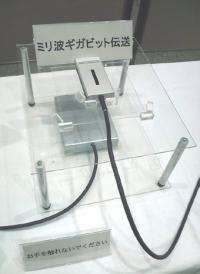(PhysOrg.com) -- The three large Japanese manufactures, Hitachi, Panasonic Corp., and Toshiba Corp, have announced that they are developing radio frequency (RF) transceiver ICs in the 60GHz band. All three manufactures plan to make ultra-small transceiver modules with integrated antennas that will be used in digital home electronics.
By utilizing the 60GHz radio frequency spectrum, a bandwidth of approximately 7GHz will make it possible to have transfer rate of 1.5 Gigabits per second. As compared to 802.11g of 54Mbs, this technology offers a much larger transfer speed. At a transfer rate of 1Gbs, it would be possible to download a 640MB CD in about 5 seconds or a 2-hour SD quality video in about 9 seconds.
Three manufactures shown here with their millimeter-wave transceiver modules: (a) Hitachi integrates LNA, mixer, VCO, etc. (b) Toshiba's single-chip RF transceiver. (c) Panasonic's millimeter-wave transceiver module.
Because of an unknown market demand for millimeter-wave communication, Japanese manufactures have not been actively developing this technology, until now. Expectations are now rising for market growth, supporting the release of AV equipment with the WirelessHD standard utilizing chipsets from SiBEAM, Inc. was released by Panasonic, LG Electronics, Inc., and others.
Hitachi plans to use millimeter-wave communication for the transfer of high-definition video streams between AV equipment, such as large screen TVs and Blu-ray Disc recorders.
Hitachi has already developed a prototype CMOS receiver IC. The module combines the IC with an antenna and other components supporting data communication in compliance with 802.15.3c. The IC was manufactured using 130nm CMOS technology, and integrates a VCO (voltage-controlled oscillator), mixer, and low-noise amplifier (LNO).
Panasonic is focusing on applications that will be used in mobile phones and they are hoping to single-chip the whole package using CMOS technology.
Toshiba wants to use millimeter-wave communication to make completely cordless digital equipment. The company is currently working on an RF transceiver IC that uses the semiconductor chip bonding wires as the antenna. Toshiba is hoping to come up with a single-chip solution that can be made with CMOS technology and does not require a dedicated antenna or other components.
The first products, using millimeter-wave communication, could appear as early as the second half of this year.
© 2010 PhysOrg.com





















